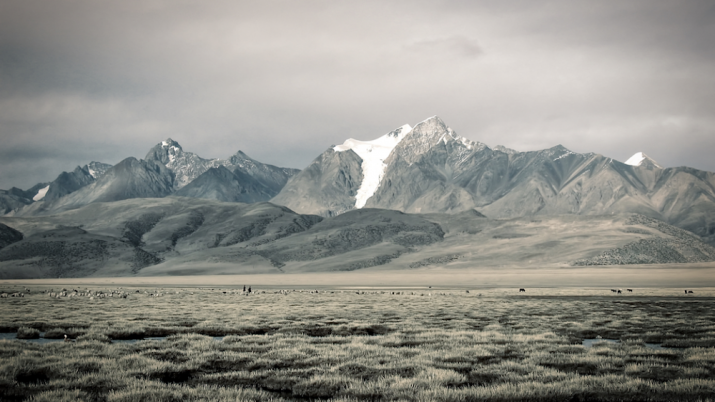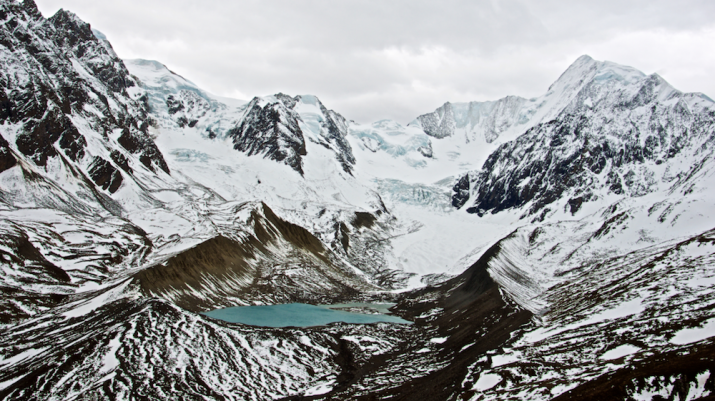NEWS
New Climate Study Bodes Ill for Asia’s Glaciers
 Researchers estimate Asia's high mountain glaciers could shrink by a third in this century as global temperatures continue to rise. Photo by Craig Lewis. From newlightdreams.com
Researchers estimate Asia's high mountain glaciers could shrink by a third in this century as global temperatures continue to rise. Photo by Craig Lewis. From newlightdreams.comA new climate study published in the scientific journal Nature offers a dire outlook for Asia’s water-giving glaciers, estimating that they could shrink by at least one-third by the end of the current century due to climate change. The forecast assumes that efforts to reduce manmade climate change are successful in preventing global temperatures from rising more than 1.5ºC above pre-industrial levels.
Asia’s high-altitude glaciers in the Himalayan region are sometimes referred to as the Earth’s “third pole” as they contain the largest concentration of frozen water outside of the planet’s two polar regions. These glaciers feed many of the region’s great rivers, including the Brahmaputra, the Ganges, and the Indus, carrying water to almost half of the world’s population, who use it for human consumption, agriculture, and hydro-energy. The glaciers have been disproportionately affected by warming global temperatures, which have impacted not only the glaciers themselves but also precipitation patterns on the expansive Tibetan Plateau.
“As we have already considerably warmed the Earth since the industrial era, we have caused an imbalance of the glaciers,” said the study’s lead author Philip Kraaijenbrink, a geography researcher at Utrecht University in the Netherlands. “We observe their retreat almost everywhere on the globe. Even if we [do] not warm the climate any more at all, starting today, 14 per cent of the ice will be lost.” (Reuters)
In 2015, almost 200 nations endorsed the Paris climate accord, pledging to contain the average rise in global temperatures below 2ºC above pre-industrial levels in a bid to minimize the impact of manmade climate change. Scientists say the average global temperature increases have already risen by about 1ºC.
The team of researchers concedes that their model, based on a 1.5ºC average temperature increase, is a best-case scenario: “To meet the 1.5ºC target will be a task of unprecedented difficulty,” the researchers admitted. “Even then, 36 per cent (give or take 7 per cent) of the ice mass in the high mountains of Asia is projected to be lost” by 2100. (Space Daily)
 The Himalayan region is sometimes referred to as the Earth’s “third pole” as its high-altitude glaciers contain the most frozen water outside of the planet’s polar regions. Photo by Craig Lewis. From newlightdreams.com
The Himalayan region is sometimes referred to as the Earth’s “third pole” as its high-altitude glaciers contain the most frozen water outside of the planet’s polar regions. Photo by Craig Lewis. From newlightdreams.comAccording to projections under the team’s climate model, average temperature increases of 3.5ºC, 4ºC, and 6ºC could lead to Asian glacier losses of 49 per cent, 51 per cent, and 65 per cent, respectively, in the same timeframe. They underscored that Asia’s glaciers are heating up faster than the global average and are already 2ºC warmer than pre-industrial levels, noting that each degree of global warming averted would translate to preserving 7 per cent of glacial ice.
“Even if temperatures stabilize at their current level, [glacier] mass loss will continue for decades to come,” the researchers added. For the glaciers to survive, “it is essential to minimize the global temperature increase.” (Space Daily)
A separate study published by Nature in July suggested that there is only a 5 per cent chance that global warming can be contained under 2ºC, with some scientists projecting a 3ºC change to be the most likely outcome under current conditions.
As if to underline the severity of the study’s findings, recently released video footage recorded by Tibetan herders in China’s northwestern Qinghai Province shows a dramtic lava-like torrent of melting permafrost flowing through a lush valley on the Tibetan Plateau. The local authorities moved to relocate some 40 local residents—all Tibetan herders—to a safer location in the sparsely populated region.
Wang Dekai, chief scientist for natural disaster prevention in neighboring Gansu Province, told state media that permafrost normally remains frozen for years. “[Melting] usually occurs in uninhabited areas,” said Wang, noting that this was one of the first cases of permafrost thawing close to a human settlement.
Footage filmed by Tibetan herders in China’s northwestern Qinghai Province shows a
lava-like torrent of melting permafrost flowing through a lush valley. From youtube.com
Chinese government scientists have said the event was likely caused by unusually high levels of rainfall, with water seeping some 2.5 meters into the top layer of soil and melting the permafrost. The scientists observed that records from recent years showed that permafrost had been melting at a faster-than-usual rate on the Tibetan Plateau and warned that warming global temperatures would lead to further thawing.
See more
Bleak outlook for Asian glaciers (Space Daily)
Millions at risk of water shortages as Asian glaciers melt: study (Reuters)
Impact of a global temperature rise of 1.5 degrees Celsius on Asia’s glaciers (Nature)
Melting permafrost flows like lava through valley in Tibetan plateau (South China Morning Post)
Related news from Buddhistdoor Global
Climate Change in the Himalayas Signals Drought for the “Highest Village in the World”
Ice Stupas Address Springtime Water Shortage in India’s Far North
Pristine Mountain Ecosystems Under Threat from Climate Change, Study Shows
Gyalwang Drukpa Warns of Climate Change Threat to Himalayan Water Sources
Dalai Lama Heads Call for International Action on Climate Change
Related features from Buddhistdoor Global
A Call for Meditation in Action on Climate Change
Buddhistdoor View: The Dharma’s Place in the Global Climate Change Crisis














